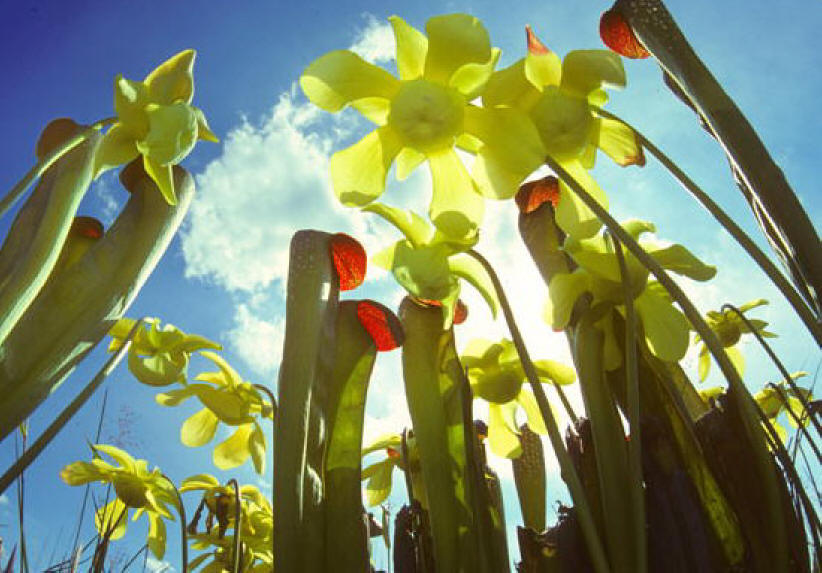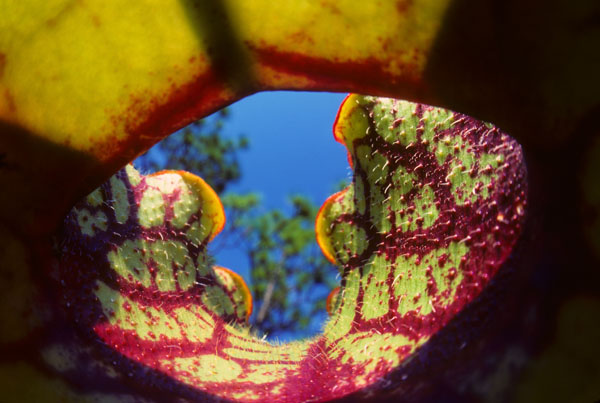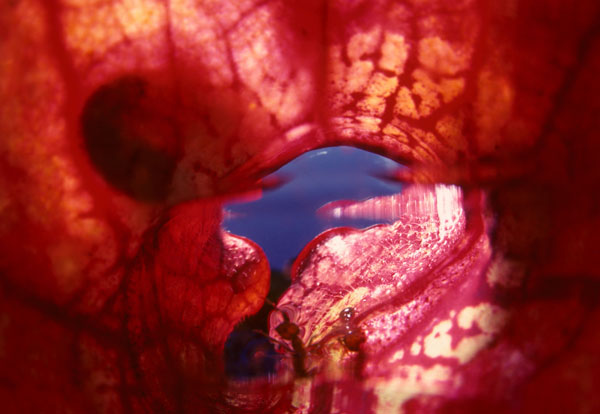Carnivorous Plants Story
Picture book for a young audience /
Kindle Edition
by
Makoto Honda
Copyright (c) 2013-2017 by Makoto Honda.
All Rights Reserved.
_______
Pitcher Plants
GENUS Sarracenia
There are eight species of eastern North American pitcher plants all
native to the eastern part of the United States. One of them also grows in the
northeastern U.S. and Canada. Often, many different species are seen growing in
the same habitats in the marshy savannas of the southeastern United States. This
creates many natural hybrids in the wild.

White-top
pitchers of Sarracenia leucophylla with a distinct network of red veins,
in the long-leaf pine savanna in southern Alabama, in May. A field covered with
thousands of fresh, spring pitchers presents a true spectacle of nature's
creation.

A stand of
the trumpet pitcher plant, Sarracenia flava, in July, in the Florida
panhandle. The tall pitchers are susceptible to wind, especially when the
pitchers are filled with rainwater, and the leaves are easily toppled after a
violent storm.

Pale yellow
flowers of Sarracenia alata. Note the shadows of the fallen pollen
accumulated on an umbrella-shaped style of the flower. In April, in southern
Mississippi.

The hooded
pitcher plant, Sarracenia minor, growing in a grassland, in a sparsely
populated pine forest, in Georgia, in May. Note brightly red ceiling of the
pitcher hood, which insects approaching the pitcher from below, will see.

In the
southeastern United States, where many different species of pitcher plants grow
in the same habitats, there are many hybrids occurring in the wild. This is a
natural hybrid between Sarracenia purpurea and Sarracenia leucophylla.
In May, in southern Alabama.

A
magnificent colony of Sarracenia purpurea plants growing in a marl fen
along the shore of Lake Huron, in northern Michigan, in early July. Other
carnivorous plants found in this northern fen include sundews and bladderworts.

A colony of
Sarracenia rubra plants by the edge of a pond in the western Florida
panhandle, in May. Note that these S. rubra plants are a giant form,
growing to a height of 70 cm.
All pitcher plants use a pitfall trap to catch insects and other small animals. The name "pitcher plants" came from their hollow trap leaves which are, indeed, shaped like a pitcher. The pitcher leaves vary in size from several centimeters to a meter in height, depending on the species. The shape of a pitcher is characteristic to each species.

A blooming
Sarracenia leucophylla plant in Florida, in May. Typically, flowers
appear before the pitchers, in order to protect pollinators. Here, new spring
pitchers are seen with red, attractive flowers atop the tall flower stems.

Pitcher plant leaves are hollow tubes that retain some liquid at the bottom. Pitchers are usually erect, but may be lying on the ground in some species. The lower part of the inner tube is covered with downward-pointing hairs to prevent insect escape.


Downward-pointing hairs on the walls of the lower pitcher (left), and captured
prey accumulating in the pitcher.

The sturdy
look of trumpet pitcher plants (Sarracenia flava) in Florida, in May.
Note a strong brownish venation, along with a dark throat, of this strain.

A clump of
pitchers strongly diffused with bright red. Sarracenia leucophylla, in
Alabama, in May.
People in the eighteenth century believed that the pitchers are intended to provide a merciful refuge for poor insects fleeting from their predators. On the contrary, we now know, the hollow pitcher leaves are carefully constructed, and deceptively clever, traps of these meat-eating plants.

Pitchers of
the hooded pitcher plant (Sarracenia minor) in Georgia, in May. A wasp
busily checks the availability of nectar near the pitcher opening, moving from
one pitcher to another.

Small flies
congregate on the neck column of the pitcher of Sarracenia leucophylla,
as a small spider nearby looks on. Note tiny downward-pointing hairs lining the
inner surface of the pitcher lid.

A cross
section of a leaf of the parrot pitcher plant (Sarracenia psittacina).
Unlike other species of pitcher plants, the hood of the pitcher is well
developed to form a dome in this species. Consequently, the pitcher opening
faces towards the rosette center. In this species, the pitchers are often lying
horizontally, instead of growing erect as in other species. Note very long
retentive hairs growing in the pitcher tube.

A view of
the pitcher top, as seen from the bottom of the pitcher of Sarracenia minor.
Note the bright red ceiling, and numerous white patches on the back side of the
pitcher. These white patches give a false impression of an exit for insects
foraging on the rim of the pitcher.

This is an
insect's eye view of blossoming Sarracenia minor plants in Georgia, in
May. As a winged insect hovers around the plants from below, seductive, bright
red ceilings of the pitchers shine alongside the attractive pale yellow-green
flowers. Sarracenia minor is an exception among all pitcher plant species
in that new spring pitchers emerge before or together with flowers, thus
exposing their pollinators to the risk of being trapped by the pitchers.
In addition to their brilliant colors, the pitchers produce sweet nectar from many nectar glands scattered over the pitcher, particularly around the lid and the mouth of the pitcher, in an attempt to allure animal prey.
Pitchers of
Sarracenia leucophylla, in May, in southern Alabama. Note a heavy
venation on the white top of the pitcher. One strain has an almost pure-white
pitcher top.
The inner surface of the pitcher lid is covered with many short hairs all pointing downward, in the direction of the pitcher opening. This creates a very unstable foothold for the foraging insects. An insect comes to the pitcher mouth where the nectar is most abundant, but the rim of the pitcher mouth is very slick. As the insect ventures around the pitcher mouth for more nectar, it often loses its footing and tumbles into the bottom of the narrow pitcher tube. Once it has fallen, the pitcher wall is too slippery for the insect to scale. The lower part of the tube has dense, downward-pointing hairs, which prevent the trapped insect from climbing the wall.
The pitcher usually contains a small amount of liquid at the base. The captured prey is eventually decomposed by bacteria, and the nutrients from the victim is absorbed through the pitcher wall.
Water-filled
pitchers of Sarracenia purpurea. Note the water level has been adjusted
by the plant for the most effective trapping. In early July, in northern
Michigan.

A bug's eye
view of the pitcher of Sarracenia purpurea, looking up from the bottom of
the pitcher. Note the vertical lip of the pitcher is lined with many short hairs
all pointing downward. Heavy markings on the inner lid provide a visual
attraction for the potential prey.

Underwater
photography reveals local ants drowning in the pool of a Sarracenia purpurea
pitcher. In July, in North Carolina.
PITCHER PLANTS NEXT
INTRODUCTION
PITFALL TRAPS FLYPAPER
TRAPS SNAP-TRAPS
SUCTION TRAPS VENUS
FLYTRAP SUNDEWS
PITCHER PLANTS COBRA
PLANT BUTTERWORTS
BLADDERWORTS
Carnivorous
Plants Story - Copyrighted Material
Copyright (c) 2013 by Makoto Honda. All Rights Reserved.
Email: mhondax@gmail.com
__________________
For
a young audience, click
here for
"Eaten Alive by Carnivorous Plants" by Kathleen J. Honda & Makoto Honda